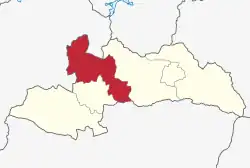Msalala | |
|---|---|
_(14760292556).jpg.webp) Drawing of Urima village from l883 | |
 Msalala District location in the Shinyanga Region | |
| Coordinates: 3°35′46″S 32°26′42″E / 3.596°S 32.445°E | |
| Country | |
| Region | Shinyanga Region |
| District | Msalala District |
| Established[1] | 2013 |
| Headquarters | Masabi, Mega |
| Government | |
| • Type | Council |
| • Chairman[2] | Mibako Mabubu |
| • Director[2] | Edward Charles Fussi |
| Area | |
| • Total | 2,635.52 km2 (1,017.58 sq mi) |
| Population | |
| • Total | 272,249 |
| • Density | 100/km2 (270/sq mi) |
| Time zone | UTC+3 (EAT) |
| Postcode[4] | 37xxx |
| Area code | 028 |
| Website | District Website |
Msalala District is a district council in the Shinyanga Region of Tanzania's lake zone established in 2012. The district lies in the middle of the region just north-east of the town of Kahama.
History
The district was created in 2012 by splitting the Kahama District into two new councils of Msalala District and Ushetu District.[1]
Geography
Msalala district lies in the middle of the Shinyanga Region between the Shinyanga District in the east, and Kahama Town in the west. To the north of the district is the Geita Region, and to the south the Tabora Region. The district covers an area of 2,635.52 square kilometres (1,017.58 sq mi).[1][5]: 12
Climate
The districts climate is hot semi-arid with the BSh Koppen-Geiger system classification. The average temperature is 24.2 °C (75.6 °F) with an average rainfall of 624 millimetres (24.6 in).[6]
Administrative divisions
Msalala has one division, 18 wards, and 92 villages.[5]: 12
Wards (2016 population)[3]: 131
- Bugarama (19,839)
- Bulige (11,407)
- Bulyan’ hulu (27,504)
- Busangi (12,495)
- Chela (22,542)
- Ikinda (7,376)
- Isaka (14,426)
- Jana (17,481)
- Kashishi (14,561)
- Lunguya (13,588)
- Mega (10,823)
- Mwakata (9,125)
- Mwalugulu (19,604)
- Mwanase (16,177)
- Ngaya (13,770)
- Ntobo (10,955)
- Segese (19,940)
- Shilela (10,636)
Demographics
In 2016 the Tanzania National Bureau of Statistics report there were 272,249 people in the district, from 250,727 in 2012. People of the district are of the tribes of Wasukuma, Wasumbwa, and Wanyamwezi with small populations of Waha, Wahangaza and Wadakama.[3]: 131 [1]
Economy
Msalala's economy is primarily agriculture. Primary crops are rice, maize, lentils, peanuts, and cotton. There are many large gold and diamond mines in and near the district such as Bulyanhulu Gold Mine, Buzwagi Gold Mine, and the Williamson diamond mine.[7][5]: 26
Education
The district has 96 primary schools and 17 secondary schools.[5]: 31
Health
Msalala has 4 health centers and 28 clinics. In 2018, 143,203 (52%) of the population had safe and reliable clean water.[5]: 30-32
Infrastructure

Roads
Masala District has 25 square kilometres (9.7 sq mi) of paved road, 205 km2 (79 sq mi) of gravel road, and 485 km2 (187 sq mi) of dirt road for a total road network of 715 km2 (276 sq mi). A paved national trunk road that runs between the city of Shinyanga and town of Kahama through Isaka, and southern part of the district, near the border with the Tabora Region.[1][8]
Rail
A metre-gauge railway of the Mwanza branch of Central Line runs through the district with a station in Isaka. A second new standard-gauge railway of the Tanzania Standard Gauge Railway line is currently being built that will also have a station in Isaka. Isaka is the end point of phase 3 and starting point of phase 4 of the Tanzania SGR project. The phase 3 (lot 2) between Isaka and Tabora was awarded in July, 2022 and began construction in August 2022, while the phase 4 between Isaka and Mwanza began construction in 2021.[9][10]
References
- 1 2 3 4 5 6 "Historia". msalaladc.go.tz (in Swahili). Masabi: Msalala District Council. Archived from the original on 18 June 2022. Retrieved 7 September 2022.
- 1 2 "Halmashauri ya Wilaya ya Msalala". msalaladc.go.tz (in Swahili). Masabi: Msalala District Council. Archived from the original on 16 July 2022. Retrieved 7 September 2022.
- 1 2 3 2016 Makadirio ya Idadi ya Watu katika Majimbo ya Uchaguzi kwa Mwaka 2016, Tanzania Bara [Population Estimates in Administrative Areas for the Year 2016, Mainland Tanzania] (PDF) (Report) (in Swahili). Dar es Salaam, Tanzania: National Bureau of Statistics. 1 April 2016. Archived (PDF) from the original on 27 December 2021. Retrieved 3 July 2022.
- ↑ "Shinyanga Postcodes" (PDF). Tanzania Communications Regulatory Authority. Archived (PDF) from the original on 29 July 2022. Retrieved 16 August 2022.
- 1 2 3 4 5 "Shinyanga Region Investment Guide" (PDF). shinyanga.go.tz. Shinyanga: United Nations Development Programme. 2020. Archived (PDF) from the original on 19 June 2022. Retrieved 7 September 2022.
- ↑ "Climate Shinyanga (Tanzania)". climate-data.org (in English and German). Germany: Climate-data. Archived from the original on 1 April 2022. Retrieved 8 September 2022.
- ↑ "Kilimo". msalaladc.go.tz (in Swahili). Masabi: Msalala District Council. Archived from the original on 18 June 2022. Retrieved 7 September 2022.
- ↑ "Shinyanga Region Roads Network" (PDF). tanroads.go.tz. Dodoma, Tanzania: TANROADS. Archived (PDF) from the original on 22 June 2022. Retrieved 8 September 2022.
- ↑ Elias, Peter (2 December 2021). "Danadana majaribio treni ya SGR Dar - Moro". Mwananchi Communications (in Swahili). Dar es Salaam, Tanzania: Mwananchi Communications. Archived from the original on 2 December 2021. Retrieved 8 September 2022.
- ↑ Artymiuk, Simon (9 August 2022). "Tanzania and Zambia agree to upgrade Tazara railway". International Railway Journal. Dodoma, Tanzania: International Railway Journal. Archived from the original on 1 September 2022. Retrieved 8 September 2022.